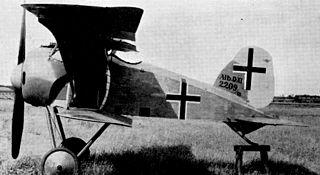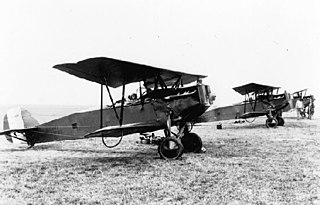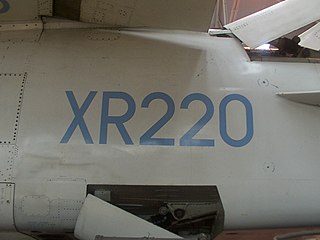The United States Military Aircraft Designation System was first designed in 1919 when the US Army's Aeronautical Division became the United States Army Air Service. Before this aircraft were put into service under their manufacturers' designations.
British military aircraft designations are used to refer to aircraft types and variants operated by the armed forces of the United Kingdom.

An attack aircraft, strike aircraft, or attack bomber is a tactical military aircraft that has a primary role of carrying out airstrikes with greater precision than bombers, and is prepared to encounter strong low-level air defenses while pressing the attack. This class of aircraft is designed mostly for close air support and naval air-to-surface missions, overlapping the tactical bomber mission. Designs dedicated to non-naval roles are often known as ground-attack aircraft.

The Lewis gun is a First World War–era light machine gun. Designed privately in America but not adopted, the design was finalised and mass-produced in the United Kingdom, and widely used by troops of the British Empire during the war. It had a distinctive barrel cooling shroud and top-mounted pan magazine. The Lewis served to the end of the Korean War, and was widely used as an aircraft machine gun during both World Wars, almost always with the cooling shroud removed, as air flow during flight offers sufficient cooling.
The Japanese military aircraft designation systems for the Imperial period (pre-1945) had multiple designation systems for each armed service. This led to the Allies' use of code names during World War II, and these code names are still better known in English-language texts than the real Japanese names for the aircraft. A number of different schemes were simultaneously in use.

The Bofors 40 mm gun, often referred to simply as the Bofors gun, is an anti-aircraft autocannon designed in the 1930s by the Swedish arms manufacturer AB Bofors. It was one of the most popular medium-weight anti-aircraft systems during World War II, used by most of the western Allies as well as some captured systems being used by the Axis powers. A small number of these weapons remain in service to this day, and saw action as late as the Persian Gulf War.

The Air Medal (AM) is a military decoration of the United States Armed Forces. It was created in 1942 and is awarded for single acts of heroism or meritorious achievement while participating in aerial flight.

The Idflieg designation system was used to classify German heavier-than-air military aircraft from the early days of the Fliegertruppe/Luftstreitkräfte to the end of World War I. The system evolved during this period as new classes of aircraft came into use.

The Tri-Service aircraft designation system is a unified system introduced in 1962 by the United States Department of Defense for designating all U.S. military aircraft. Prior to then, the U.S. armed services used separate nomenclature systems.

A United States Department of Defense aerospace vehicle designation is determined by a detailed protocol which identifies all aircraft, helicopters, rockets, missiles, spacecraft, and other aerial vehicles in military use by the United States Armed Forces.

The Deutsche Luftstreitkräfte —known before October 1916 as Die Fliegertruppen des deutschen Kaiserreiches abbreviated to Die Fliegertruppe—was the air arm of the Imperial German Army. In English-language sources it is usually referred to as the Imperial German Air Service, although that is not a literal translation of either name. German naval aviators of the Marine-Fliegerabteilung were an integral part of the Imperial German Navy. Both military branches operated aeroplanes, observation balloons and airships.

The P-1 Hawk was a 1920s open-cockpit biplane fighter aircraft of the United States Army Air Corps. An earlier variant of the same aircraft had been designated PW-8 prior to 1925.

The Boeing Model 15 was a United States single-seat open-cockpit biplane fighter aircraft of the 1920s, manufactured by the Boeing company. The Model 15 saw service with the United States Army Air Service and with the United States Navy as a carrier-based fighter.
From 1922 until 1962, the United States Navy, the United States Marine Corps and the United States Coast Guard used a system to designate their aircraft that included information about a craft's role and its manufacturer. For a listing of all such designations, see the list of United States Navy aircraft designations (pre-1962).

The Consolidated PT-1 Trusty was a biplane primary trainer used by the United States Army Air Service (USAAS).

The Huff-Daland Type XV Training Water-Cooled TW-5 was a biplane trainer designed by the Huff-Daland Aero Corporation in the early 1920s for the United States Army Air Service.

United Kingdom military aircraft serial numbers are aircraft registration numbers used to identify individual military aircraft in the United Kingdom (UK). All UK military aircraft are allocated and display a unique registration number. A unified registration number system, maintained initially by the Air Ministry (AM), and its successor the Ministry of Defence (MoD), is used for aircraft operated by the Royal Air Force (RAF), Fleet Air Arm (FAA), and Army Air Corps (AAC). Military aircraft operated by government agencies and civilian contractors are also assigned registration numbers from this system.

The Curtiss T-32 Condor II was a 1930s American biplane airliner and bomber aircraft built by the Curtiss Aeroplane and Motor Company. It was used by the United States Army Air Corps as an executive transport.
The United States military aircraft engine designation system was introduced in 1926, originally for piston engines it was expanded in the 1947 to include a separate system for jet and rocket engines.
In 1924, problems with the previous designation system led to a general revamping of the designation system used by the United States Army Air Service. This system was to remain in effect with the U.S. Army Air Corps, the U.S. Army Air Forces and the independent U.S. Air Force, as well as those aircraft remaining in the U.S. Army after 1947. With some minor changes it became the basis of the 1962 United States Tri-Service aircraft designation system.













